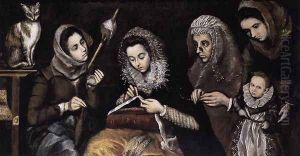Jorge Manuel Theotokopoulos Paintings
Jorge Manuel Theotokopoulos, born in 1578 in Toledo, Spain, was the son of the renowned Greek painter Doménikos Theotokópoulos, widely known as El Greco. Despite living in the shadow of his father's towering legacy, Jorge Manuel carved out his own niche in the world of Renaissance art, contributing significantly to the continuation of his father's stylistic innovations and to the cultural life of Toledo during the late 16th and early 17th centuries. His birth into an environment steeped in artistic creativity and innovation undoubtedly influenced his career path and his development as an artist.
Jorge Manuel's training began in his father's workshop, where he was immersed in the Mannerist style that characterized El Greco's work. This early exposure not only honed his technical skills but also deeply ingrained in him the unique blend of Byzantine traditions and Western painting techniques that his father had perfected. By working closely with El Greco, Jorge Manuel became an integral part of the workshop, eventually taking on significant projects and collaborations with his father. This partnership is most notably seen in their joint work on the Hospital de Tavera altarpiece and the decoration of the Iglesia de Santo Domingo el Antiguo in Toledo.
Following El Greco's death in 1614, Jorge Manuel inherited his father's workshop and continued to work in Toledo, maintaining the distinctive style that had made his father famous. While much of his own work is often overshadowed by that of El Greco, Jorge Manuel achieved recognition in his own right, particularly for his architectural projects. Notably, he was responsible for the design of the Chapel of San José in Toledo and contributed to the construction of the city's Town Hall. These architectural endeavors reveal his versatility and creativity, extending his influence beyond painting to leave a lasting mark on Toledo's architectural heritage.
Jorge Manuel Theotokopoulos's contributions to the Spanish Renaissance, though less celebrated than those of his father, underscore the continuity of artistic vision and skill across generations. His efforts to preserve and extend El Greco's legacy, both through his paintings and architectural works, demonstrate the enduring impact of familial artistic traditions. He died in 1631 in Toledo, having spent his life dedicated to the arts and to enriching the cultural fabric of his city. Through his works, both in painting and architecture, Jorge Manuel ensured that the unique artistic language developed by his father would resonate through the ages, a testament to the blend of cultural influences that defined the Renaissance period in Spain.
